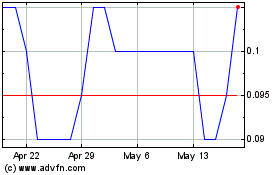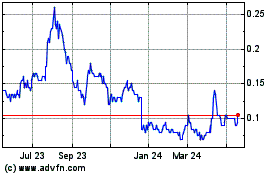Juggernaut discovers strong Eskay-style VHMS target in outcrop on Midas
15 December 2021 - 11:45PM

Juggernaut Exploration Ltd (JUGR.V) (The
“Company” or
“Juggernaut”)
is pleased to report the discovery of a new outcrop with
strong indications for an Eskay-style Volcanic Hosted Massive
Sulphide (VHMS) target. This newly discovered outcrop contains high
grade gold-silver polymetallic mineralization in semi-massive to
massive sulphides where a 1 m chip sample assayed 9.343 gpt Au, 117
gpt Ag, 1.58 % Cu and 1.77 % Zn. This newly discovered outcrop is
located 700 m in the headwaters of a drainage where a Bulk Leach
Extractable Gold (BLEG) stream sediment sample assayed 29 ppb Au,
613 ppb Ag, 137 ppm Cu, 54.4 ppm Pb and 462 ppm Zn. The outcrop is
5 m wide and strikes on surface for 30 m and remains open in all
directions where outcrops of the same or similar lithology extend
over several hundred meters. The new Kokomo
showing consists of pyrite, sphalerite and chalcopyrite and
coincides with a linear magentic-high feature and a low
conductivity signature in the Induced Polarization (IP). The host
rock is a rhyolitic tuff characterized by strong phyllic alteration
(quartz-sericite-pyrite).
-
Eskay-style VHMS Target (Kokomo showing)
highlights:
- New
Kokomo showing where a 1 m chip sample assayed 9.343 gpt Au, 117
gpt Ag, 1.58 % Cu and 1.77 % Zn. The outcrop is 5 m wide and
strikes on surface for 30 m and remains open in all directions
where outcrops of the same or similar lithology extend over several
hundred meters. (Y606015
Image)
- BLEG
sample collected 700 m down-slope in the drainage of the newly
discovered Kokomo showing assayed 29 ppb Au, 613 ppb Ag, 137 ppm
Cu, 54.4 ppm Pb and 462 ppm Zn, by far the highest BLEG sample
recorded on the property and is coincident with a similar
geochemical signature as the Kokomo showing.
(Prospective NW-SE Trend
Map)
- Two
outcrop grab samples collected within 50 m of the newly discovered
Kokomo showing in 2018 and 2019 assayed 1.835 gpt Au (with 34.4 gpt
Ag, 0.84 % Cu, 0.03 % Pb and 0.79 % Zn) and 2.29 gpt Au (with 21.3
gpt Ag, 0.01 gpt Cu, 0.00 % Pb and 0.02 % Zn).
(B066625 Grab
Sample)
- Newly
discovered outcrop coincides with a linear magentic-high feature
and a low conductivity signature in the Induced Polarization (IP).
(IP Geophysical Survey)
(SKYTEM Geophysical Survey)
(TMI geophysical
Survey)
- The host
rock to the new showing has been mapped by Juggernaut former senior
geologist S. Roach as well as the British Columbia Geological
Survey (BCGS; M. McKeown, J. Nelson and R.
Friedman, 2007) as a rhyolitic tuff with strong
phyllic alteration (quartz-sericite-pyrite) from the Mt Attree
volcanics, a unit highly prospective for VHMS deposits.
(Detailed Geological Map)
(New Outcropping VHMS
Target)
- In 2018, drill
hole MD-18-16 intersected 0.21 gpt Au, 1.77 gpt Ag and 0.32 % Zn
over 35.35 m and was collared 530 m south of the new Kokomo
showing. This hole was drilled at an azimuth of 270 and a dip of 50
likely intersecting the distal parts of the system outcropping at
the Kokomo showing. (See News Release October 9,
2018)
- The Sub showing
located 400 m northwest of Kokomo where lenses of massive sulphides
were reported by the BCGS grading 0.275 gpt Au, 18.3 gpt Ag, 0.02 %
Cu, 0.31 % Pb and 0.44 % Zn is believed to be a peripheral feeder
zone below the sea floor. (BCGS Nelson
Image)
- The stratigraphy
includes andesiste, rhyolite and rhyolitic tuff of the Mt Attree
formation which are Mississippian in age. Mississippian age rocks
are known to host the majority of significant VHMS deposits.
(VHMS Mineralization
Potential)
- Alteration on
the new Kokomo showing and the King Solomon trend includes
quartz-sericite-pyrite (phyllic alteration), silicification and
Fe-rich chlorite (including an intense depletion of Na2O and CaO)
increasing in intensity from west to east. This alteration pattern
is useful in providing a vector to the centre of the system.
(Midas Alteration Box
Plot)
- Several untested
IP chargeability and resistivity, and magnetic anomalies
surrounding the new Kokomo showing and the King Solomon trend
remain untested. (IP Geophysical
Survey) (SKYTEM Geophysical
Survey) (TMI geophysical
Survey)
- Widespread Zn
signature with secondary Au, Ag, Pb, Cu and trace element signature
(elevated Au, Te, As, Sb, Bi, Cd, Hg, Ba).
(Midas
Geochemistry)
- Midas is
within a world class geologic setting with strong potential for
Eskay-style VHMS mineralization
The newly discovered showing is located
northeast of the King Solomon trend and has been mapped by the
British Columbia Geological Survey (BCGS; M. McKeown, J.
Nelson and R. Friedman, 2007) as a
conformable sequence of layered Paleozoic felsic to mafic
subaqueous volcaniclastic rocks including lenses of massive
sulphide surrounded by an extensive alteration zone consistent with
VHMS deposits as described at the nearby Sub showing located 400 m
NW from the nesw Kokomo showing. Samples collected by the BCGS from
the Sub showing returned 0.275 gpt Au, 18.3 gpt Ag, 0.02 % Cu, 0.31
% Pb and 0.44 % Zn. Joanne Nelson stated in her report (on
page 112) that the Sub and Gazelle showings demonstrate
mineralization indicative of a VHMS deposit, most likely peripheral
VHMS feeder zone below the seafloor, that have been discovered in
an intensely-altered body within the Mt Attree volcanics.
The Company has previously exposed the strong potential of the King
Solomon Trend showing that rocks and soil samples have geochemistry
consistent with VHMS deposits. Strong IP and Magnetotellurics (MT)
chargeability and resistivity anomalies have been tested during
drill campaigns in 2018 and 2019 further improving the
characterization of this VHMS system (See
News Release from October 9, 2018)
(January 8, 2019)
(September 30, 2019). In
2018, drill hole MD-18-16 intersected 0.21 gpt Au, 1.77 gpt Ag and
0.32 % Zn over 35.35 m and was collared 530 m south of the new
Kokomo showing. This hole was drilled at an azimuth of 270 and a
dip of 50 likely intersecting the distal parts of the system
outcropping at the Kokomo showing. (See
News Release from October 9, 2018). In
2019, hole MD-19-21 located 800 m southeast of Kokomo, closest to
the East Creek fault, displayed textures consistent with VHMS
including a 0.5 m interval of semi massive to massive pyrite from
47 to 47.5m containing 0.213 gpt Au with 6.03 gpt Ag and 0.368 % Cu
hosted within strongly sericite to silica altered rock
(See News Release September 30,
2019).
The Kokomo showing has strong potential
to evolve into a significant new VHMS discovery which is supported
by geochemistry, geology, ground and airborne geophysics. Based on
the data to date, Juggernaut’s Exploration Team believes some of
the best targets remain to be drill tested. Eskay Creek
was discovered in 1988. The 109th drilling hole of Stikine
Resources and Calpine Resources’ joint venture hit the jackpot with
a content of 27.2 gpt Au and 30.2 gpt Ag on 208 m. This mine had
Canada’s richest content with 49 gpt Au, 2406 gpt Ag, 3.2 % Pb and
5.2 % Zn. Obviously, Stikine’s stock price skyrocketed, going from
$0.30 to $64 within a year before the company was bought by a major
player.
Based on the discovery of the Kokomo
showing a systematic follow up program is strongly recommended on
the Kokomo Zone and surrounding area consisting of additional
mapping and sampling in preparation for drilling.
(2022 Prospecting Area
Map)
The Midas property is located 24 km southeast of
Terrace, British Columbia in close proximity to logging access
roads, power, railway and major infrastructure. The property is 100
% controlled by Juggernaut Exploration.
Dan Stuart, President and CEO of
Juggernaut Exploration, states: We are very excited with
the discovery of the new Kokomo VHMS target, through systematic
exploration it appears we have vectored onto to what we have been
looking for. This demonstrates there is strong potential for VHMS
Eskay-style mineralization on Midas that remains to be drill
tested. We look forward to the fully funded 2022 Exploration season
with much anticipation.
Empire property update:
A BLEG sampling campaign was carried out on the
Empire property targeting creeks draining from the Colossus and Big
One geophysical anomalies. Samples returned assays ranging from
0.46 ppb Au and 0.058 gpt Ag to 5.98 ppb Au and 0.519 gpt Ag.
Ongoing compilation of the extensive datasets, including LiDAR,
SkyTEM, ground IP and MT, airborne magnetic surveys, geological
mapping, alteration studies, geochemistry, drill data,
chip/grab/channel data as well as the recently collected BLEG
stream sediment data, will be utilized to help develop targets for
follow up for a potential feeder source at depth believed to be the
source of the extensive high-grade gold and polymetallic
mineralization confirmed on surface on the Empire Property.
Qualified Person
Rein Turna P. Geo is the qualified person as
defined by National Instrument 43-101, for Juggernaut Exploration
projects, and supervised the preparation of, and has reviewed and
approved, the technical information in this release.
Other
Grab samples are collected, described,
georeferenced, bagged and tagged by Juggernaut’s exploration crew
in the field and are transported by helicopter to the staging area,
and then transported by truck to the industrial yard where they
were prepared for shipping. Standards, blanks and duplicates were
added in the sample stream at a rate of 20 %. All samples,
including rock grabs, channels and talus samples, are transported
in rice bags sealed with numbered security tags. A transport
company takes them from the yard to the ALS labs facilities in
North Vancouver or MSA labs facilities in Langley. ALS (and MSA) is
either Certified to ISO 9001:2008 or Accredited to ISO 17025:2005
in all of its locations. At ALS (and MSA), samples are processed,
dried, crushed, and pulverized before analysis using the ME-ICP61
and Au-ICP21 (ICP-130, ICA-5Ag, and FAS-124) methods. Overlimits
are re-analyzed using the ME-ICP61, Au-ICP21, and Ag-GRA21
(FAS-428, ICA-6Ag, and FAS-425) methods. If gold is higher than 5
gpt, the labs will re-analyze using Metallic Screening Au-SCR24C
(MSC-150) method. The reader is cautioned that grab samples are
spot samples which are typically, but not exclusively, constrained
to mineralization. Grab samples are selective in nature and
collected to determine the presence or absence of mineralization
and are not intended to be representative of the material
sampled.
For more information, please contact:
Juggernaut Exploration Ltd.
Dan Stuart
President and Chief Executive Officer
Tel: (604)-559-8028
www.juggernautexploration.com
NEITHER THE TSX VENTURE EXCHANGE NOR ITS
REGULATION SERVICES PROVIDER (AS THAT TERM IS DEFINED IN THE
POLICIES OF THE TSX VENTURE EXCHANGE) ACCEPTS RESPONSIBILITY FOR
THE ADEQUACY OR ACCURACY OF THIS RELEASE.
FORWARD LOOKING STATEMENT
Certain disclosure in this release may
constitute forward-looking statements that are subject to numerous
risks and uncertainties relating to Juggernaut’s operations that
may cause future results to differ materially from those expressed
or implied by those forward-looking statements, including its
ability to complete the contemplated private placement. Readers are
cautioned not to place undue reliance on these statements. NOT FOR
DISSEMINATION IN THE UNITED STATES OR TO U.S. PERSONS OR FOR
DISTRIBUTION TO U.S. NEWSWIRE SERVICES. THIS PRESS RELEASE DOES NOT
CONSTITUTE AN OFFER TO SELL OR AN INVITATION TO PURCHASE ANY
SECURITIES DESCRIBED IN IT.
Juggernaut Exploration (TSXV:JUGR)
Historical Stock Chart
From Jan 2025 to Feb 2025

Juggernaut Exploration (TSXV:JUGR)
Historical Stock Chart
From Feb 2024 to Feb 2025
